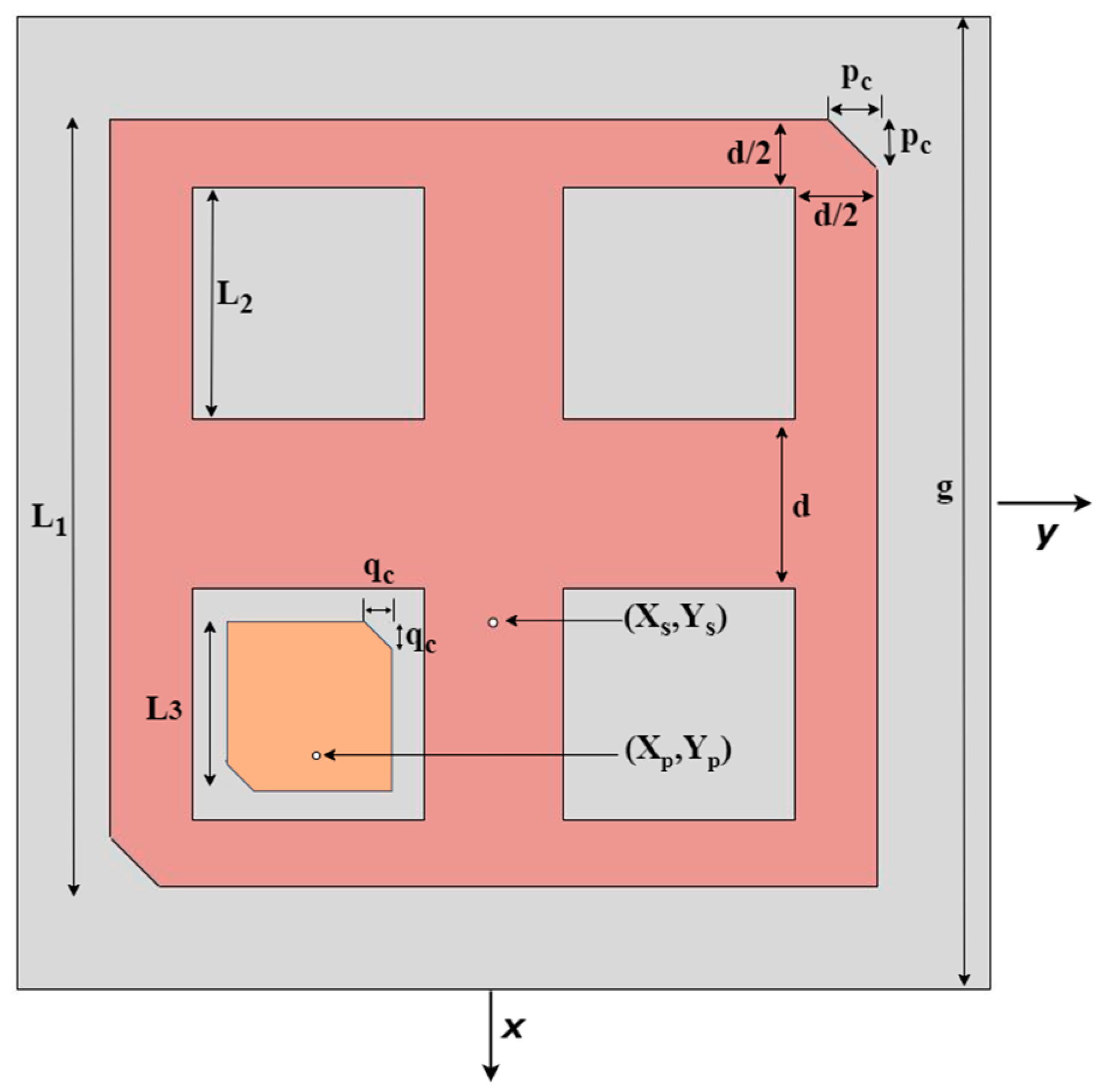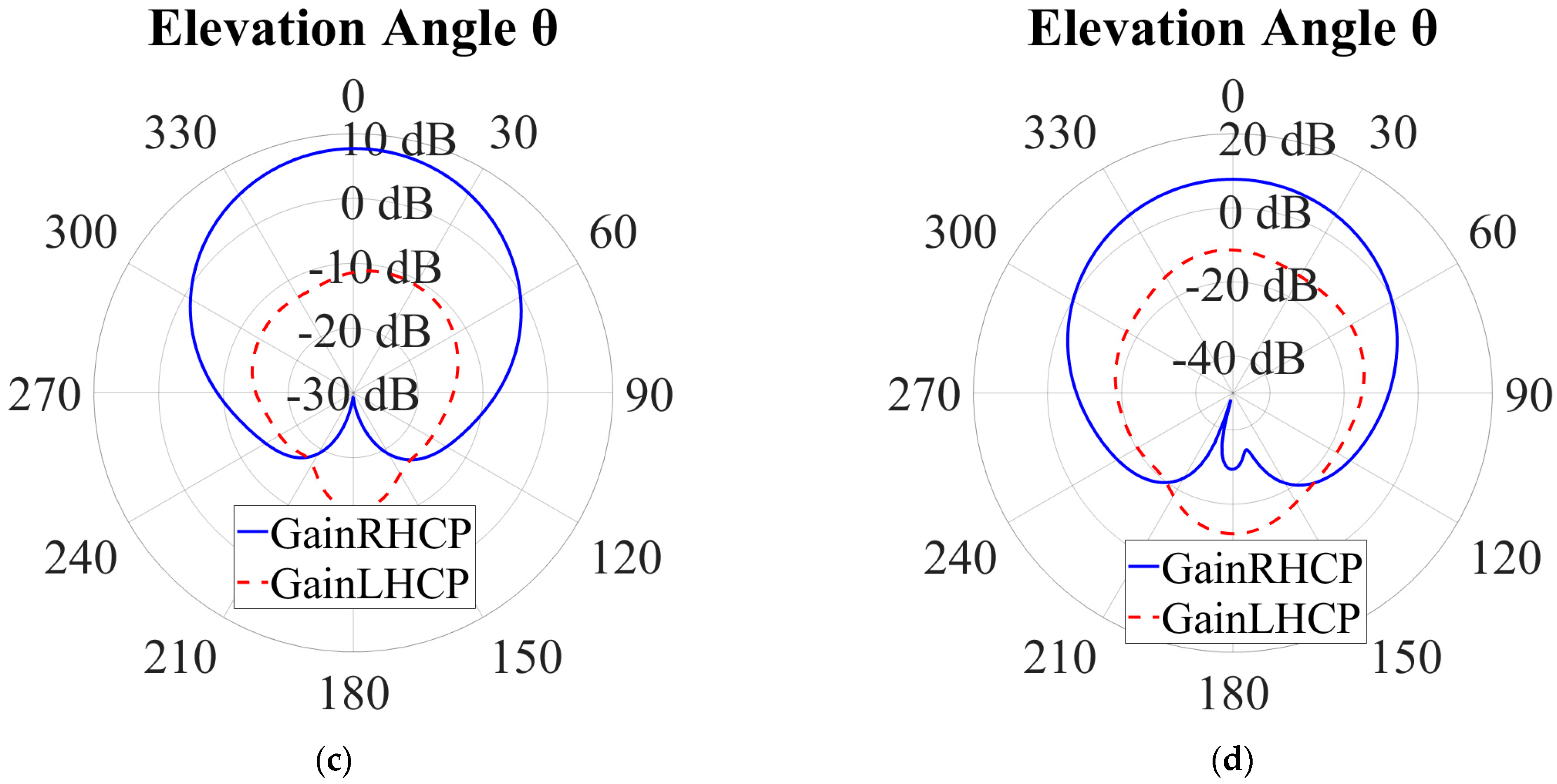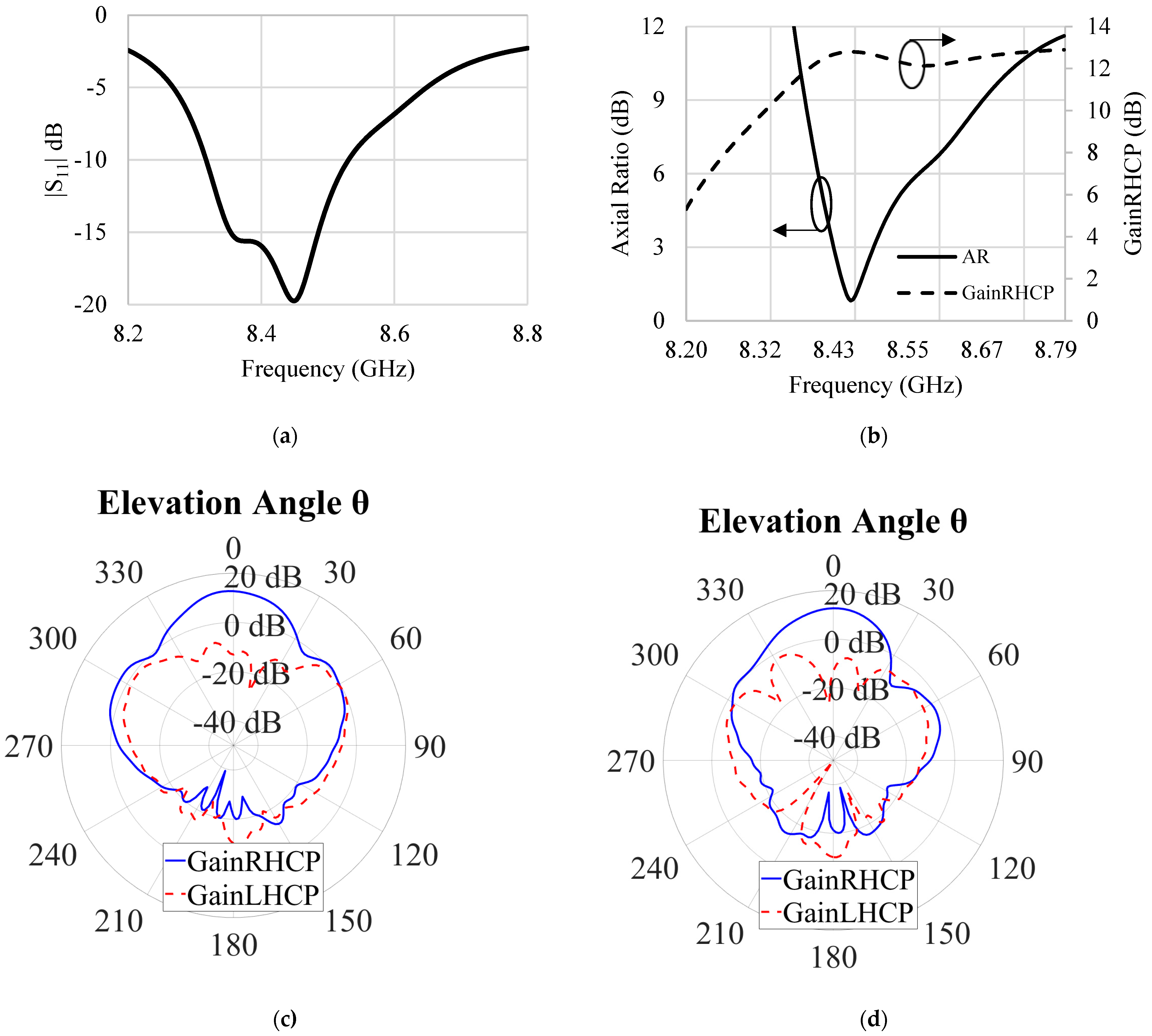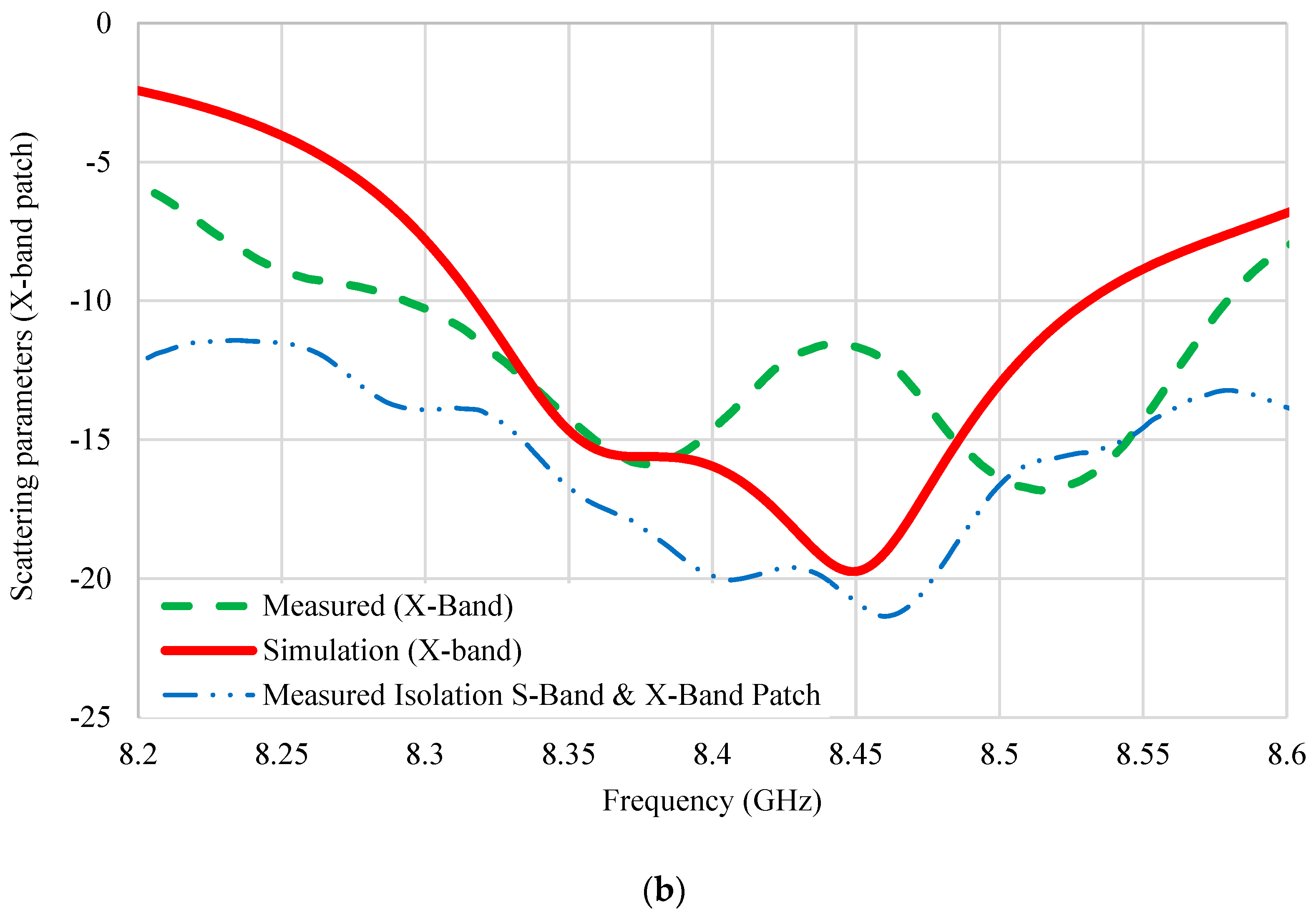A Multi-Band Circularly Polarized-Shared Aperture Antenna for Space Applications at S and X Bands
Abstract
:1. Introduction
- Telemetry, tracking and command (TT&C) for uplink and downlink communications with the ground station;
- High speed downlink communication for large payload data when downloaded;
- GNSS (GPS, Galileo, etc.);
- Inter-satellite communication.
2. Proposed Antenna Geometry
3. Results
3.1. Simulated Results
3.2. Antenna Prototype Fabrication and Measurement
4. Discussion
5. Conclusions
Author Contributions
Funding
Data Availability Statement
Conflicts of Interest
References
- Gao, S.; Clark, K.; Unwin, M.; Zackrisson, J.; Shiroma, W.A.; Akagi, J.M.; Maynard, K.; Garner, P.; Boccia, L.; Amendola, G.; et al. Antennas for Modern Small Satellites. IEEE Antennas Propag. Mag. 2009, 51, 40–56. [Google Scholar] [CrossRef]
- Liddle, J.D.; Holt, A.P.; Jason, S.J.; O’Donnell, K.A.; Stevens, E.J. Space Science with CubeSats and Nanosatellites. Nat. Astron. 2020, 4, 1026–1030. [Google Scholar] [CrossRef]
- Cappelletti, C.; Battistini, S.; Malphrus, B. (Eds.) Cubesat Handbook: From Mission Design to Operations; Academic Press: Cambridge, MA, USA, 2020. [Google Scholar]
- The CubeSat Program, California Polytechnic State University—San Luis Obispo “CubeSat Design Specification Rev. 13”; California Polytechnic State University: San Luis Obispo, CA, USA, 2014.
- Imbriale, W.A.; Boccia, L. Space Antenna Handbook; Wiley Online Library: Hoboken, NJ, USA, 2012. [Google Scholar]
- Le Vine, D.M.; Jacob, S.D.; Dinnat, E.P.; De Matthaeis, P.; Abraham, S. The Influence of Antenna Pattern on Faraday Rotation in Remote Sensing at L-Band. IEEE Trans. Geosci. Remote Sens. 2007, 45, 2737–2746. [Google Scholar] [CrossRef]
- Deshpande, M.; Piepmeier, J. Design and Development of VHF Antennas for Space Borne Signal of Opportunity Receivers for CubeSat Platforms. In Proceedings of the IEEE International Symposium on Antennas and Propagation and North American Radio Science Meeting, Vancouver, BC, Canada, 19–24 July 2015. [Google Scholar]
- Joseph, A.T.; Deshpande, M.; O’Neill, P.E.; Miles, L. Development of VHF (240–270 MHz) antennas for SoOp (Signal of Opportunity) Receiver for 6U CubeSat Platforms. In Proceedings of the 2016 Progress in Electromagnetic Research Symposium (PIERS), Shanghai, China, 8–11 August 2016; pp. 2530–2531. [Google Scholar]
- Chahat, N.; Sauder, J.; Thomson, M.; Hodges, R.; Rahmat-Samii, Y. CubeSat deployable ka-band reflector antenna for deep space missions. In Proceedings of the 2015 IEEE International Symposium on Antennas and Propagation & USNC/URSI National Radio Science Meeting, Vancouver, BC, Canada, 19–24 July 2015; pp. 2185–2186. [Google Scholar]
- Hodges, R.E.; Radway, M.J.; Toorian, A.; Hoppe, D.J.; Shah, B.; Kalman, A.E. ISARA-integrated solar array and reflectarray cubesat deployable ka-band antenna. In Proceedings of the 2015 IEEE International Symposium on Antennas and Propagation & USNC/URSI National Radio Science Meeting, Vancouver, BC, Canada, 19–24 July 2015; pp. 2141–2142. [Google Scholar]
- Warren, P.A.; Steinbeck, J.W.; Minelli, R.J.; Mueller, C. Large, Deployable S-band antenna for a 6U CubeSat. In Proceedings of the 29th Annual American Institution Aeronautics and Astronautics/Utah State University Conference Small Satellites, Santa Clara, CA, USA, 8–13 August 2015; pp. 1–7. [Google Scholar]
- Tubbal, F.E.; Raad, R.; Chin, K.W. A Survey and Study of Planar Antennas for Pico-Satellites. IEEE Access 2015, 3, 2590–2612. [Google Scholar] [CrossRef]
- Vourch, C.J.; Drysdale, T.D. Inter-CubeSat communication with V-Band ‘Bull’s Eye’ antenna. In Proceedings of the 8th European Conference on Antennas and Propagation (EuCAP 2014), Hague, The Netherlands, 6–11 April 2014; pp. 3545–3549. [Google Scholar]
- Hossain, M.M.; Kabir, S.S.; Latif, S.I.; Spencer, E.; Qudrat-E-Maula, M. A wideband stacked patch-patch antenna with hybrid perturbations for circular polarization. In Proceedings of the 2021 IEEE International Symposium on Antennas and Propagation and USNC-URSI Radio Science Meeting (AP-S/URSI), Singapore, 4–10 December 2021; pp. 55–56. [Google Scholar]
- Liu, S.; Theoharis, P.I.; Raad, R.; Tubbal, F.; Theoharis, A.; Iranmanesh, S.; Abulgasem, S.; Khan, M.U.A.; Matekovits, L. A Survey on CubeSat Missions and Their Antenna Designs. Electronics 2022, 11, 2021. [Google Scholar] [CrossRef]
- Axness, T.A.; Coffman, R.V.; Kopp, B.A.; O’Haver, K.W. Shared Aperture Technology Development. Johns Hopkins APL Tech. Dig. 1996, 17, 285–294. [Google Scholar]
- Wang, S.; Zhang, L.; Zhu, K.; Sun, H. Multi-band shared aperture circularly polarized antenna with metal isolation columns. In Proceedings of the 2022 IEEE MTT-S International Wireless Symposium (IWS), Harbin, China, 12–15 August 2022; pp. 1–3. [Google Scholar]
- Xie, M.; Wang, Z.; Sun, L.; Zhu, S.; Deng, G.; Cao, Z. An L/S multi-band shared-aperture circularly polarized antenna. In Proceedings of the 2021 13th International Symposium on Antennas, Propagation and EM Theory (ISAPE), Zhuhai, China, 1–4 December 2021; pp. 1–3. [Google Scholar]
- Gaffar, M.; Zaman, M.A.; Choudhury, S.M.; Matin, M.A. Design and Optimisation of a Novel Dual-Band Circularly Polarised Microstrip Antenna. IET Microw. Antennas Propag. 2011, 5, 1670–1674. [Google Scholar] [CrossRef]
- Rivera, A.; Stewart, A. Study of spacecraft deployables failures. In Proceedings of the European Space Mechanisms and Tribology Symposium, Virtual, 20–24 September 2021. [Google Scholar]
- Kabir, S.S.; Latif, S. Multi-band shared aperture antenna for satellite communications. In Proceedings of the 2022 IEEE International Symposium on Antennas and Propagation and USNC-URSI Radio Science Meeting (AP-S/URSI), Denver, CO, USA, 10–15 July 2022; pp. 1814–1815. [Google Scholar]
- Rao, S.; Shafai, L.; Sharma, S.K. (Eds.) Handbook of Reflector Antennas and Feed Systems Volume III: Applications of Reflectors; Artech House: Norwood, MA, USA, 2013. [Google Scholar]
- Chen, W.-S.; Wu, C.-K.; Wong, K.-L. Square-Ring Microstrip Antenna with a Cross Strip for Compact Circular Polarization Operation. IEEE Trans. Antennas Propag. 1999, 47, 1566–1568. [Google Scholar] [CrossRef]
- Orr, R.; Goussetis, G.; Fusco, V. Design Method for Circularly Polarized Fabry–Perot Cavity Antennas. IEEE Trans. Antennas Propag. 2013, 62, 19–26. [Google Scholar] [CrossRef]
- Abbak, M.; Tekin, I. RFID Coverage Extension Using Microstrip-Patch Antenna Array. IEEE Antennas Propag. Mag. 2009, 51, 185–191. [Google Scholar] [CrossRef]
- Mathur, P.; Kumar, G. Dual-Frequency Microstrip Antenna at S and X Bands with Higher-Order Mode Suppression Technique. IET Microw. Antennas Propag. 2018, 12, 583–587. [Google Scholar] [CrossRef]
- Serup, D.E.; Williams, R.J.; Zhang, S.; Pedersen, G.F. Shared aperture dual S- and X-band antenna for nano-satellite applications. In Proceedings of the 2020 14th European Conference on Antennas and Propagation (EuCAP), Copenhagen, Denmark, 15–20 March 2020; pp. 1–4. [Google Scholar]
- Bandi, R.B.; Kothapudi, V.K.; Pappula, L.; Kalimuthu, R.; Gottapu, S.K. A Single-Layer S/X-Band Shared Aperture Antenna with MIMO Characteristics at X-Band for Airborne Synthetic Aperture Radar Applications. Int. J. Antennas Propag. 2023, 2023, 1384388. [Google Scholar] [CrossRef]








| Antenna Parts | Parameters | Symbol | Value (mm) |
|---|---|---|---|
| Antenna Main Structure | Dielectric Layer-1 height | h | 0.787 mm |
| Dielectric Layer-2 height | h | 0.787 mm | |
| Air gap distance | ha | 16.2 mm | |
| Dielectric Layer-3 height | hu | 2.5 mm | |
| All dielectric layers and ground Plane length | g | 60 mm | |
| S-band Patch | Square Ring antenna length | L1 | 41.7 mm |
| Square Ring antenna slot length | L2 | 13.8 mm | |
| Square Ring patch corner perturbation length | pc | 2.2 mm | |
| Distance between slots | d | 7.05 mm | |
| Square Ring antenna feed location | (Xs, Ys) | (5.7, 0) mm | |
| X-band Patch | X-band square patch length | L3 | 10.8 mm |
| X-band square patch corner perturbation length | qc | 1 mm | |
| X-band patch feed location | (Xp, Yp) | (12.3, −10.4) mm |
| Ref. | Freq. Bands | AR BW (%) | Gain (dBic) | Antenna Volume (mm3) | Polarization |
|---|---|---|---|---|---|
| [26] | S-/X-band | NA | 8/11.5 | 140 × 140 × 9.4 | Linear |
| [27] | S-/X-band | 1/1.4 | 6.55/12.5 | 82 × 82 × 4 | RHCP |
| [28] | S-/X-band | NA | 7.2/12.4 | 100 × 100 × 1.6 | Linear |
| Proposed work | S-/X-band | 0.35/0.8 | 7.7/12.8 | 60 × 60 × 20 | RHCP |
Disclaimer/Publisher’s Note: The statements, opinions and data contained in all publications are solely those of the individual author(s) and contributor(s) and not of MDPI and/or the editor(s). MDPI and/or the editor(s) disclaim responsibility for any injury to people or property resulting from any ideas, methods, instructions or products referred to in the content. |
© 2023 by the authors. Licensee MDPI, Basel, Switzerland. This article is an open access article distributed under the terms and conditions of the Creative Commons Attribution (CC BY) license (https://creativecommons.org/licenses/by/4.0/).
Share and Cite
Kabir, S.S.; Khan, M.H.; Latif, S.I. A Multi-Band Circularly Polarized-Shared Aperture Antenna for Space Applications at S and X Bands. Electronics 2023, 12, 4439. https://doi.org/10.3390/electronics12214439
Kabir SS, Khan MH, Latif SI. A Multi-Band Circularly Polarized-Shared Aperture Antenna for Space Applications at S and X Bands. Electronics. 2023; 12(21):4439. https://doi.org/10.3390/electronics12214439
Chicago/Turabian StyleKabir, Syed Salman, Mehedi Hassan Khan, and Saeed I. Latif. 2023. "A Multi-Band Circularly Polarized-Shared Aperture Antenna for Space Applications at S and X Bands" Electronics 12, no. 21: 4439. https://doi.org/10.3390/electronics12214439






